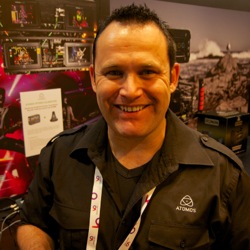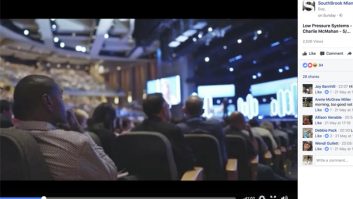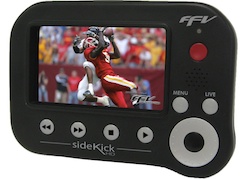
Sales of external recorders have rocketed over the past few years, as they have become smaller, lighter and more capable. Atomos, the market leader, has now sold more than 30,000 units across all of its products. Its low prices are a major factor in this success, making its recorders a must-have for DSLR users, but the appeal of the on/off-camera recorder is much wider than this.
The market for its HDMI-based Ninja 2 is currently 60% DSLR users, 20% buying it for new cameras and 20% using it to upgrade old cameras, while the SDI-based Samurai Blade is 30% DSLR (it can do HDMI via a convertor), 40% new, 20% older, and 10% switchers.
Some 4K cameras need external recorders to cope with the high resolution, such as Canon’s C500, or Sony’s PMW-F5 (which uses Sony’s own AXS-R5 RAW Recorder to record RAW 4K at up to 120fps).
“I think the real revolution is the external device being capable of more than the camera is,” says Atomos’ CEO, Jeromy Young (pictured). “This is a simple equation: cameras have a lot of heat, and the more the data the more the heat. Separating recording from the sensor and making it external means we can pipe more data and record higher quality than the internals of the camera, resulting in better image quality from your camera.
“It’s also about the use of commodity computer storage as media, something that not only saves money but allows for a tape-like ‘keep the original’ workflow that we all loved about tape,” he adds. “Computers solved high data rates and large storage years ago and that lends itself to recording computer friendly codecs like Apple ProRes and Avid DNxHD.”
Why go external?
“No one simply shoots with a camera any more. We use camera systems and we need to be aware of the post paths for the finishing of our projects. A proper recorder is flexible enough both to capture from the different cameras one might use as well as output the different formats post may require,” says Mitch Gross (pictured), director of Communications, Convergent Design. “It is not enough for a tool to serve a single function. Cameras seem to have more devices and contraptions hanging off them everyday. A high-end recorder that also functions as a reference-grade monitor and is still small and light and power-friendly enough to be mounted on a camera serves to help a cinematographer in his work, not hinder it.”
“I hate calling them recorders because actually it’s only a quarter of what they do,” adds Young. It’s not just the recording, but also the monitor and deck functionality. It was only when Atomos addressed all of the functions required by cameramen (including peaking and waveform monitoring) that the sales really took off. “Audio monitors are also important and we have truly gone to town on the accuracy and functionality,” he claims. “However in essence these devices are a bridge from production to post production so the real value actually happens after the camera, and in our case on the set with cut editing. It’s all about the increased speed and quality of workflow and that’s what our customers understand.”
Codex VP for Market Development, Sarah Priestnall, says reliability, size and workflow are the key drivers for external recorders: “Recorded data is the equivalent of a film negative so any recording device must be extremely reliable,” as must the recording media. “Any recording device must be small so as not to overly increase the size of the camera package.” And “the recorder is just the beginning of a workflow that goes from production through post to the ultimate distribution of the product. Having a simple, robust workflow is key, including the implementation of industry standards like ACES,” she says.
“Key market drivers for powerful and flexible external recorders continue to be the proliferation of new cameras and the multi-format on-set and delivery demands of today’s productions,” says Bryce Button (pictured), product marketing manager, AJA Video Systems. Its new Ki Pro Quad supports multiple monitoring options from 4K SDI to dedicated downconversion, with both HD-SDI out and HDMI, which he says turns it into a 4K/UHD processing hub on set.
“One of the key drivers for Cinedeck is format flexibility, and Cinedecks deliver virtually every file format required for any production workflow across episodic TV, live, OB, post production and archiving applications,” claims Suzette Ferguson, Cinedeck senior VP of Worldwide Sales. Its units can also deliver the required format, written to the most appropriate destination, eliminating copying and moving media. “In general, many facilities are still in transition to a fully file-based production chain and recording appliances like Cinedeck fill the need for SDI sources to go direct to file storage.”
One of the biggest reasons for turning to external recorders is the proliferation of formats, adds Ferguson. “Cinedecks deliver hundreds of the most commonly used combinations with more being added on a regular basis. There is no end in sight for this growth because there is effectively no ‘End of Life’ for a file and codec technology is constantly advancing.”
There are two key needs in the market, according to Vitec product manager, Richard Bernard. One is driven by ease of editing with the main non-linear editing software, for which ProRes/DNxHD recorders are best suited, but with the downside of large file sizes, while the other is a need for small file sizes, where more efficient video codecs are required, something that he feels “will become even more crucial” with 4K. “Also, more and more, recorders are or will be connected to the network for sharing, collaborative work, direct transfer to online video platform (YouTube, Vimeo, etc). All our recorders at Vitec have such capabilities and users are starting to embrace this new way of working on video clips.”
Beyond the DSLR
DSLRs may still be a large market for external recorders, but their appeal is much broader now. For Cinedeck, “leveraging older cameras into newer file formats is still a factor. Cinedecks are commonly used in multi-camera environments where tape machines used to be king. Additionally, Cinedecks remove the restriction of single or limited format recorders allowing recording quality and format to be selected at production time,” says Ferguson.
AJA has the small HDMI-equipped Ki Pro Mini for DSLRs, which supports the CF Cards used by most high-end stills cameras, but its live event customers generally choose the 1RU Ki Pro Rack, which fits easily in a flight case and allows gang recording across units for multiple cameras with shared timecode. Its very long record times with DNxHD or ProRes makes it a favourite for long concerts and conferences.
“Much of the separate recorder market is in keeping alive old cameras or boosting the capabilities of modest cameras,” says Gross. “There is also the need to record proxies or duplicate files. But we tend to focus on higher-level functionality. Our product’s about taking the outputs from some of the highest-level cameras available and raising them beyond their internal capabilities. RAW recording is available on very few cameras, as is 4K capture. We also add an interface with our touchscreen panel that fundamentally changes the way one interacts with the cameras themselves. We like to think that we deliver a more complete integrated camera solution.”
Gross believes that 4K is a particularly interesting area for external recorders because so little has been agreed on standards for delivery. “There are some cameras and there are some displays, and then there’s a whole lot of open space in between them. We believe that for 4K to become increasingly adopted this space must be filled with all sorts of hardware and software.” Manufacturers are already creating competing 4K formats, so “an external recorder capable of capturing and/or outputting to these various flavours will become valuable,” he says.
“4K will have a huge impact on the external recorder market, and we’re already seeing that impact with the popularity of our Ki Pro Quad recorder,” adds Button. “People want to invest in technology that will work for them today, but also meet their needs in the future.”
Codex has been recording 4K for many years, going back to the use of its studio recorders with the Dalsa camera on films like Quantum Of Solace. “Currently, our Onboard S recorder is able to record 4K at up to 120fps with the Canon C500 camera,” says Priestnall.
Vitec’s approach now for 4K is using a proxy workflow based around its FS-H70 recorder, with the RAW 4K/8K clips recorded in camera, resulting in huge files that are difficult to deal with. The FS-H70 stores a proxy clip in 1080p H.264 at 8Mbps (or less) for easy editing, with auto-conform to finish without having to ingest all the rushes. “This is a great saving in ingest/editing time, material investment, etc,” says Bernard.
“4K means a LOT of data, perhaps far more than people realise. It means an exponential growth in recording media, computing power, storage and transfer and encoding times,” adds Gross.
Young sees 4K, RAW and 120fps HD as the next big developments, but predicts that this will be over HDMI initially “as 3G SDI doesn’t cut it and 6G is too slow for the real deal, only doing 4:2:2 4K at 24p and QHD up to 30p. 4:4:4 60p 4K can not be done until 12G is a reality, which is probably IBC next year for products.
“We will make the 4K unit available when there are more cameras and that is probably the end of 2014 depending on take up,” he adds.
“To take advantage of the larger 4K screen, I strongly believe that 4K resolutions require 60fps to have a smooth rendering,” says Bernard. However, today 4K60p baseband video requires two 6G-SDI or four 3G-SDI connections, which he doesn’t think is a viable solution. “HDMI 2.0 for 4K60 display is available, but this is not a lockable connector. Adding to the fact that timecode cannot be provided using this interface (proprietary solutions exist however), you end up with a non-viable solution again,” he adds. A 12G SDI interface specification is coming, which would allow 4K60 with only one SDI cable. “This is more practical and will help the adoption. But it may come with limitations and more specifically with a limited maximal cable length between the camera/video source and receiver: that may be a showstopper for some applications,” he says, wondering if it is time to break with SDI and move to fibre.
4K workflow
One of the problems with working with 4K is that each camera manufacturer has a different approach.
For Codex, “it’s really a case of which companies will allow partners to develop recording solutions (ARRI, Canon) and which would rather keep recording proprietary (Sony). However, even for Sony, while we can’t make recorders that work with the F55 and F5, we do offer a workflow solution using Codex Vault to clone, archive, review and make deliverables from camera original data recorded to Sony’s media,” explains Priestnall.
“If a manufacturer chooses to restrict access to their image data stream, that makes working with their product difficult. Beyond that it really is a matter of horse power,” adds Ferguson.
“You need to be able to handle both RAW workflows and baseband,” says Button. “The Ki Pro Quad provides this with debayering for the Canon C500 as well as baseband support for a camera like the Sony F55.”
Gross believes there will be many 4Kworkflows. “For some it will mean more powerful machines. For others it will mean working with more heavily compressed file formats. For others still it will mean using smaller proxy files until they have to go back to the 4K material to finish a project. None of this is new, but people tend to forget that we had the same struggles just a few years ago when we were dealing with HD and less powerful computers.”
“4K generally means more data to move around, particularly if uncompressed. Any 4K workflow must be able to clone and verify data as quickly as possible so that the original camera media can be recycled back to set. 4K playback and visual QC are also vital. Codex Vault enables the cloning and archiving of media from various cameras (such as ARRI, Sony, Canon, Red) plus the creation of dailies. The Review module allows for playback and visual QC of material. This can be in an on-set or near-set environment or even in a remote location as Vault can run off a battery,” says Priestnall. “Different cameras are being used on productions so Codex Vault provides a simple, unified workflow no matter what camera is used.”
Run to record: The latest in external recorders
AJA’s Ki Pro Quad records 4K, UHD, 2K and HD in 10-bit 4:4:4 and 10-bit 4:2:2 and can output to attached DIT workstations via Thunderbolt, while debayering and encoding to Apple ProRes files on inserted AJA solid-state Pak Disks for ready-to-edit files. It includes an uncompressed and debayered 4K monitoring output plus HD monitoring via SDI and HDMI.
ARRI recently introduced the Alexa XT camera, which uses an in-camera ARRIRAW module developed by Codex, recording at up to 120fps (16:9). It uses Codex Capture Drives inside the Alexa, saving space and the need for cables. “Bringing recording inside the camera has proven a huge success, although Codex Onboard S and Onboard M recorders continue to be used on major feature films, television shows and commercials,” says Priestnall. SanDisk’s new CFast 2.0 CompactFlash card format, developed with ARRI, allows higher-speed, higher resolution capture, and is one reason the Amira (the first camera to use it) can record 200fps. “It has a write speed of 350MBps and reads at 450MBps and will also be usable on the Alexa XT and XR via a Codex adaptor” (CFast is also supported for post via Codex Vault), said Susan Park (pictured), director of retail product marketing, SanDisk. Files are closed continuously, so accidentally removing the card or suffering a power loss during recording results in a readable, uncorrupted file.
Atomos has upgraded its Samurai Blade with new software, and also introduced a new €149 calibration device, the Spyder, that can calibrate the Blade’s 1280×720 monitor to Rec. 709 or 6500K white point automatically in about a minute. “When you add the waveform, vectorscope and calibration, you really know what you are recording. It means you save time in post and you can be more creative,” says Young.
Blackmagic Design’s new $995 HyperDeck Studio 2 (HD recorder) and $1995 HyperDeck Studio Pro 2 (for 4K) are the latest versions of its rack-mounted uncompressed, ProRes and DNxHD disk and SSD recorders. The Pro 2 supports 6G-SDI and HDMI 4K connections for Ultra HD, with 4-channel SDI I/O, Thunderbolt, HDMI, XLR and analogue ports. Blackmagic hasn’t announced plans to add 4K to its more portable Shuttle recorder, but the Pro 2 indicates the direction it is taking.
Cinedeck now allows full Ultra HD and 4K RAW recording with simultaneous HD master, and Proxy editorial/deliverable files, with uniform and flexible-file naming and metadata. There is also support for simultaneous streamable H.264 to the web, via a streaming server, for remote review and approval, and for growing files, so that content can be edited/reviewed before a file is closed.
Convergent Design’s new Odyssey7 and its Odyssey7Q (due January) both have a 7.7-inch 1280×800 touchscreen OLED monitor offering a reference-grade Rec. 709 or DCI-P3 image plus exposure tools (waveform, histogram, vectorscope, false colour mode and zebra), focus tools and basic LUT control. They record to two 2.5-inch SSDs, with SDI and HDMI I/O with conversion between both.
The Odyssey7Q can record uncompressed DPX video as well as compressed formats, plus ARRIRAW, Canon RAW, and Sony RAW, for 4K recording. It can also take in up to four HD inputs, with multi-viewing, and record all four, or record three plus a programme feed (with the monitor being used as a live switcher with EDL output).
The USB Recorder from LGZ Broadcasting Technology is a new way to supply immediate and distributable copies of the recorded events, particularly suited to an OB truck. “DVDs have long fitted the bill, but these take up lots of space, offer low video quality and are quite expensive. We therefore have developed a unique solution (from what we know the only one worldwide) that records an audio video signal (HD-SDI) live on to eight USB sticks simultaneously,” says its CEO, Joachim Koitsalu (pictured). It only takes 10 seconds until eight copies on USB sticks (or drives) can be distributed, with standard H.264 HD files. It costs €2100 including a Blackmagic Design DeckLink SDI interface.
Vitec’s new Focus FS-H70 portable SDI recorder records frame-accurate timecoded H.264 clips (up to 1080p) as .MOV, MP4 or AVC HD files while being able to stream a 480×360-resolution live video over WiFi for mobile preview. Users can also operate it and review clips on its SDHC card via WiFi. “Vitec’s new FS-H60 recorder with HDMI input ships this month.
By David Fox
www.aja.com
www.arri.com
www.atomos.com
www.blackmagicdesign.com
www.cinedeck.com
www.codexdigital.com
www.convergent-design.com
www.lgztech.com
www.sandisk.com
www.vitecmm.com







